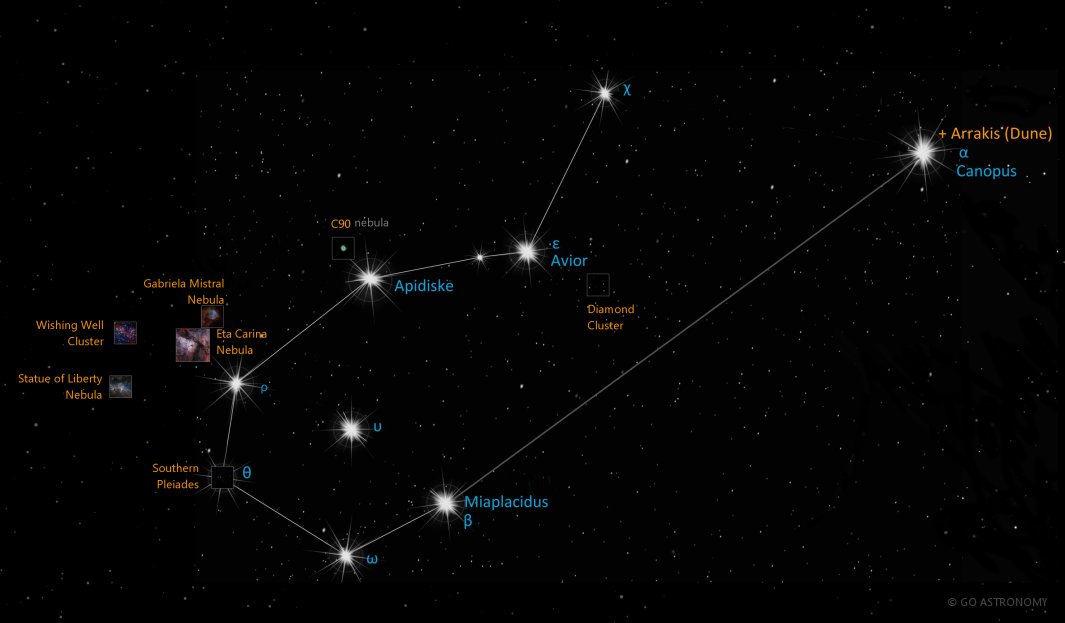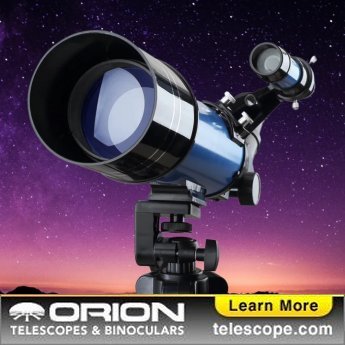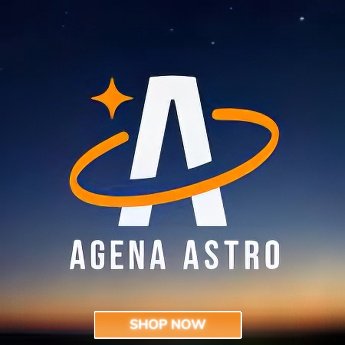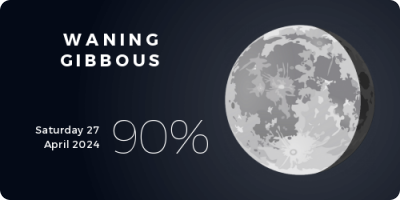Carina, the Keel (Car)
(cuh-REE-nuh)
The Southern constellation of Carina, the Keel, is best viewed in Spring during the month of March.
Carina is the 34th largest constellation. It's brightest star is Canopus at magnitude -0.72. The boundary of the Carina constellation contains 13 stars that host known exoplanets.
Carina is a circumpolar constellation, so is visible year-round in the Southern hemisphere. Conversely, it is not visible in the opposite hemisphere.
- Pronunciation:
- cuh-REE-nuh
- Meaning:
- Keel
- Genitive:
- Carinae
- Abbreviation:
- Car
- Asterism:
- Diamond Cross
- Constellation Family:
- Heavenly Waters
- Hemisphere:
- Southern
- Quadrant:
- SQ2
- Visibility:
- 20° N - 90° S
- Best viewing month*:
- March
- Area:
- 494 sq. degrees
- Size:
- 34th largest
- Circumpolar** (N=northern, S=southern):
- S circumpolar
- Right Ascension (avg):
- 7h 46m
- Declination (avg):
- -61°
- Brightest star:
- Canopus (-0.72)
- Stars with planets:
- 13
- X-ray stars:
- 4 (2 binaries) stars
- Messier objects:
- |
Brightest Stars in Carina
The 10 brightest stars in the constellation Carina by magnitude.
- Star
- Magnitude
- Spectral class
- Alpha Carinae (α Car)
- -0.72
- F0Ib
- Beta Carinae (β Car)
- 1.67
- A2IV
- Epsilon Carinae (ε Car)
- 1.86
- K3III+B2V
- Iota Carinae (ι Car)
- 2.23
- A8Ib
- Theta Carinae (θ Car)
- 2.74
- B0Vp
- Upsilon Carinae (υ Car)
- 2.92
- A9
- Omega Carinae (ω Car)
- 3.29
- B8III
- Rho Carinae (ρ Car)
- 3.3
- B4Vne
- V337 Carinae (V337 Car)
- 3.39
- K3II
- Alpha Carinae (α Car)
- 3.43
- B2IV
Star Clusters in Carina
The most notable and easy-to-find star clusters in the constellation Carina . Also see all star clusters.
- Star cluster
- Catalog #
- Cluster type
- Diamond Cluster
- open
- NGC 2808
- globular
- NGC 3114
- open
- NGC 3293
- open
- Southern Pleiades
- C102
- open
- Wishing Well Cluster
- C91
- open
Nebulae in Carina
Notable and easy-to-find nebulae in the constellation Carina . Also see all nebulae.
- Nebula name
- Catalog #
- Nebula type
- Carina Nebula
- C92
- emission
- Gabriela Mistral Nebula
- emission
- Homunculus Nebula
- reflection
- Keyhole Nebula
- dark
- Statue of Liberty Nebula
- emission
Galaxies in Carina
The most notable galaxies in the constellation Carina. Also see all galaxies.
Milky Way Satellites in Carina
Dwarf satellite galaxies that orbit the Milky Way Galaxy located in the constellation Carina. Also see all Milky Way satellite galaxies.
- Galaxy name
- Alt name
- Magnitude
- Carina Dwarf Spheroidal
- 11.3
- Carina II Dwarf
- Carina III Dwarf
The Keel of the Southern Sky
Carina is a constellation in the southern hemisphere, known for its rich collection of deep sky objects and its association with the mythical ship Argo Navis. Its name translates to "The Keel", in reference to its representation of the keel of Argo Navis, the ship used by Jason and the Argonauts in Greek mythology.
Historical Overview
Carina was once part of the larger constellation Argo Navis until French astronomer Nicolas Louis de Lacaille divided it into three smaller constellations in the 18th century: Carina (the Keel), Puppis (the Stern), and Vela (the Sails). This was done to facilitate more manageable star mapping and navigation. Today, it is one of the 88 modern constellations recognized by the International Astronomical Union.
Location and Notable Features
Carina is located in the second quadrant of the southern hemisphere (SQ2) and can be observed at latitudes between +20? and -90?. It is surrounded by the constellations of Centaurus, Chamaeleon, Musca, Pictor, Puppis, Vela, and Volans.
The brightest star in Carina, and the second brightest star in the night sky, is Canopus (Alpha Carinae), an F-type supergiant which shines with an apparent magnitude of -0.74. This luminous giant is located roughly 310 light-years away from our solar system.
Arguably the most famous object within Carina is Eta Carinae, a highly luminous stellar system that underwent a great eruption in the 19th century known as the Great Eruption, making it one of the most massive and brightest stellar systems in the Milky Way.
Deep Sky Objects
Carina is known for its remarkable deep-sky objects. The most notable of these is the Carina Nebula (NGC 3372), one of the largest diffuse nebulae in our skies, spanning over 300 light-years in diameter. The nebula is home to several O-type stars and includes the aforementioned Eta Carinae.
Carina also hosts several open clusters, such as the Theta Carinae Cluster (IC 2602), known colloquially as the Southern Pleiades, and NGC 3532, sometimes referred to as the Wishing Well Cluster.
Observing Carina
Due to its location in the southern hemisphere, Carina is best seen during the months of March and April. However, Canopus, its brightest star, can be observed for several months of the year from southern latitudes and from mid-northern latitudes at certain times of the year. As for its deep-sky objects, a small to medium-sized telescope will be required for detailed viewing.
The best way to locate Carina is to first identify the more prominent constellation of Orion, then follow the line of Orion?s belt to the left until you reach Sirius, the brightest star in the sky. From Sirius, move further down until you reach the next exceptionally bright star, which is Canopus in Carina.
Carina is a treasure trove of celestial sights that offers much for both the casual stargazer and serious astronomer. Its place in history, its bright stars, and its wealth of deep sky objects make it a standout constellation in the southern sky.
* Constellation shown for northen hemisphere skies. For the southern hemisphere, constellations appear rotated 180 degrees (upside-down and left-right reversed) from what is shown. Remember that seasons are reversed too - summer in northern latitudes is winter in southern latitudes.
** Circumpolar constellations are visible year-round in the hemisphere listed (and not at all in the opposite hemisphere).





